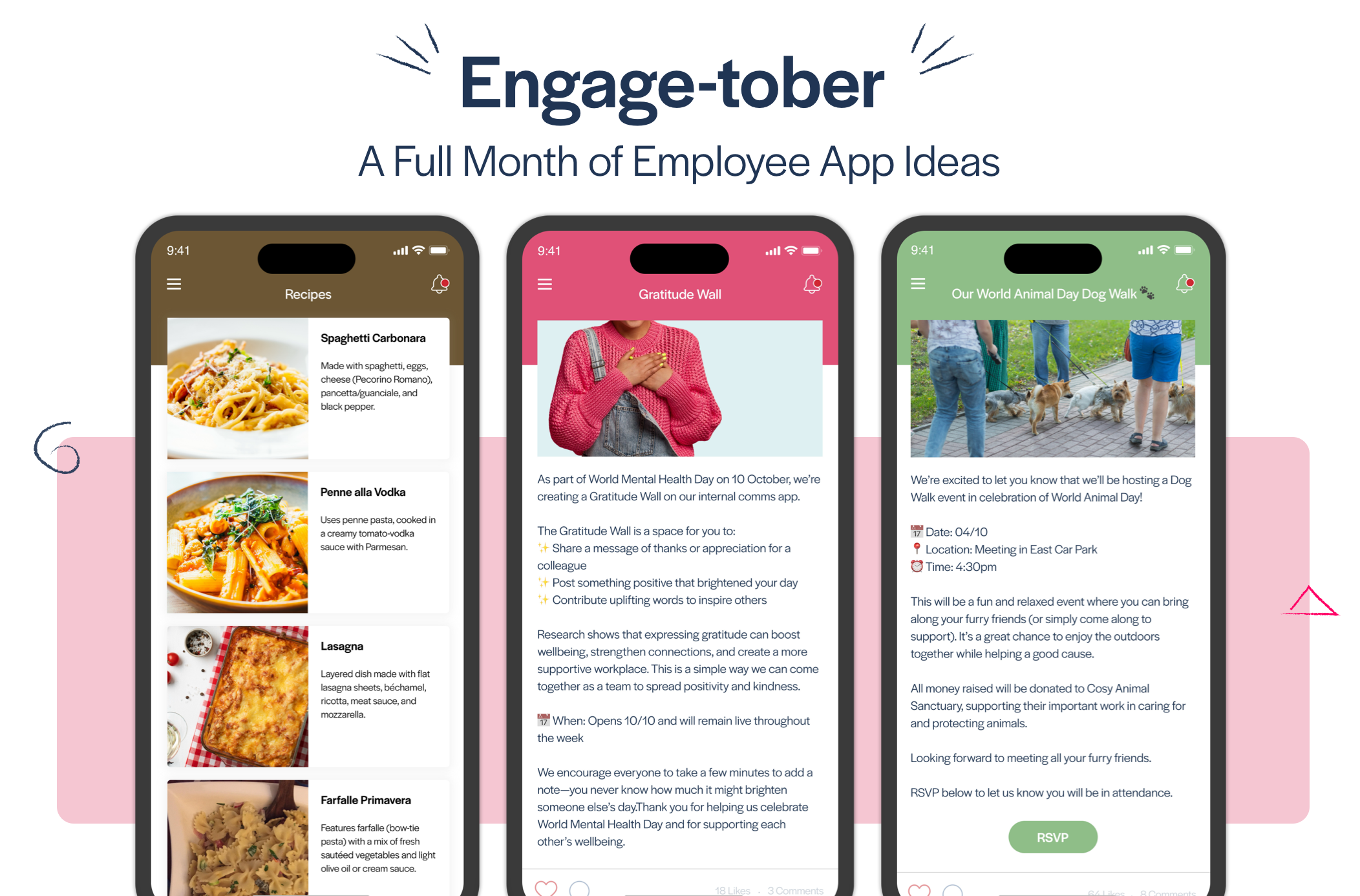
Blog
How To Create & Conduct an Employee Engagement Survey
When it comes to identifying the challenges facing your organisation, look no further than the front line. As the single most valuable resource in your operation, your employees have a wealth of opinions and information about your business. This guide will help you mine for their insights so you can implement critical changes that will bolster employee engagement for the long term.

In the wake of the global pandemic, and the Great Resignation that followed, businesses around the world find themselves in uncharted waters today. Many of the old rules and tactics of employee engagement—such as in-office perks—seem no longer to apply, as employees are seeking increased flexibility in just when, how and where they do their work.
Navigating this new operational environment requires a deeper understanding of employee motivations: what they enjoy about their current roles, and the company culture overall; what pain points they’re experiencing, and which of these could be “deal-breakers” when it comes to their longevity with your company; where they desire to grow, and ways you can incentivize them to stay with your company as they pursue those paths.
The best way to answer these questions, and to harness the insights that follow, is to conduct employee engagement surveys. Here’s what you need to know about creating and conducting these surveys, and most importantly, how to implement pivots to your employee engagement strategy based on the results.

What Is An Employee Engagement Survey?
First, what is it really? While employee engagement surveys come in many forms, they are generally designed to be conducted across the entirety of an organisation (though confidentially) to allow for a complete picture of your business. The surveys ask a series of questions—often on a 5-point Likert scale (from Strongly Agree to Strongly Disagree, for example), although certain questions may allow for open response. And they are most typically conducted on an annual basis.
Why You Need Employee Engagement Surveys
Gauge Employee Satisfaction—and Risk
Arguably the most important reason to conduct an employee engagement survey is to understand how satisfied your current workforce is. This allows you to identify the flight risk of those employees who may be planning either an imminent or eventual departure, and to understand it in tangible terms.
For example, whether dissatisfaction is concentrated among a few departments, or if it’s more widespread. Having this “finger on the pulse” of your business can help you to shore up specific areas in your operations that are contributing to employees’ decision to leave, before it’s too late.
Amplify Your Employee Voices
It’s true that in business, no matter how educated or savvy your leadership team may be, many of the best ideas can come from the broader team. Those employees who work in the day-to-day trenches of your business are often best-equipped to identify operational inefficiencies or employee engagement issues in need of attention.
By conducting employee engagement surveys, you are giving a voice to your team, demonstrating that you value their feedback and giving them an important outlet for communicating any frustrations or even ideas for improvement.

Design and Implement Organisational Improvements
The results of an employee engagement survey give you the tools and information to see what’s working in your current operation—and just as critically, what isn’t. Even with anonymised feedback, you’ll begin to see important trends in terms of specific departments or practice areas that are performing particularly high or low in terms of engagement.
This equips you to delve deeper into the “why” and “how” behind the ways these departments are run. With these insights in hand, you can implement new best practice standards and make immediate improvements to your company’s road map.
Establish Benchmarks for Employee Engagement Over Time
An initial employee engagement survey will give you invaluable insight into your current business operations, what you’re doing well, and ways you can improve. But the power is exponential when these surveys are deployed and leveraged over time. Beyond pinpointing opportunities and measuring the effectiveness of your responses to these challenges, you can measure precisely how successfully you’ve introduced change.
Benchmarks also allow you to compare your employee satisfaction across your competitive set, identifying if a challenge is industry-wide or specific to just your company—important intel as you strive to introduce real positive change.
Step-by-Step Guide to Designing an Effective Employee Engagement Survey
When it comes down to creating an employee engagement survey, the questionnaire can be as unique as your business. While there’s no strict formula, and many of the questions can be written to be completely relevant to your specific business, there are a few best practices to ensure your survey will yield the best possible results.

1. Map Out the Survey Design
Once you determine you’re going to conduct an employee engagement survey, the first step is to design the survey itself. This includes aligning on details such as whose input you’ll need (individually or departmentally), what your goals are for the survey, and what specific questions will help you achieve that goal.
This step should also factor how you plan to conduct the survey—specifically, what tools you plan to use for collecting responses—as well as how you plan to review, summarise and distribute the survey takeaways once finished.
2. Create a Project Plan
Like any workplace project, you’ll want to have a clear understanding of how you will execute it before you get started. Determine a timeline with key milestones, including who is on point for each step, when you want final internal sign-off on the questions, when you’d like to conduct the survey, as well as how long you’ll want to leave the survey “live,” which will depend heavily on where and how your employees work.
This should also include whether there will be a “read out” of the results, or if you plan to share the insights back with your employees another way—a critical piece of the survey puzzle that reinforces to your team that you hear what they have to say.

3. Identify the Themes
This step really comes down to your goals for the survey, specifically what you’re hoping to learn from it. Central to the process is the theme of employee engagement itself, including general satisfaction (on an individual basis), willingness to stay, desire for growth or change, pain points, etc.
Other questions can focus on themes about the company itself, such as the employee’s perception of the company and its culture, access to resources and training, opinions on specific leadership, and more.
4. Draft the Questions
Based on the goals of your survey, you’re ready to write the questions themselves. There’s no set number of questions, but generally 30-50 will yield the best results without asking too little on the one hand, or introducing survey fatigue on the other. Try to structure as many questions as possible using a 5-point Likert scale, structuring questions in the form of a question with 5 possible responses ranging from Strongly Agree to Strongly Disagree (or in some cases, from Very Likely to Very Unlikely).
For situations that require a bit more elaboration, it’s good to also include a follow-up question with a free-form text box that accepts open responses.
5. Bring the Data to Life
Once the survey is designed and your employees have shared their feedback with you (note: this step may take some nudging to ensure an optimal response rate), you’ll be ready to craft the story using the data you’ve collected.
Here, it’s important to remember that infographic visuals will trump a “wall of words” in just about every instance. Examine your survey results and determine the best ways to tell the story of their feedback through elements such as images, charts and graphs. Data visualisation can be the best tool for bringing complex takeaways to life, no matter who will be receiving the results.

Other Best Practices to Note
Frequency: While there’s no rule holding you to an annual employee engagement survey, this is a generally preferred timeline that provides year-over-year insights without introducing survey fatigue. If you find that you need insight more frequently throughout the year, you might consider shorter “pulse” surveys with only a few questions, designed to check in with employees in between the larger annual surveys.
Respondents: Since employee engagement surveys are designed to measure the satisfaction and flight risk of your workforce, you might consider excluding new hires from taking it. Alternatively, you could construct a version of the survey that asks more goal- and growth-oriented questions to this set of your employees, since they will have less to offer when it comes to opinions on legacy programs within your company.
Communication: At the outset of the survey, consider providing a “brief” to your employees that outlines the entire employee engagement survey process. This formal announcement can include a summary about the objectives of the survey, specifically mentioning that you value their feedback and intend to make it actionable. It should also include a project timeline informing them of the survey dates, as well as when they can expect the read-out or resulting action plan from your leadership.
Survey Integrity: To ensure you’ve captured the right feedback from your employees, and that you have a comprehensive picture of what’s working well—and what isn’t—aim for a response rate of at least 70%, but ideally 80-90%. Consider leaving the survey open for 2-3 weeks if possible within your project plan, as well as incentivizing your employees to take the survey if you find you’re not receiving timely responses.

Go Deeper
Still have questions? Check out our range of FREE eGuides and client success stories to help you get started on your employee engagement journey.









